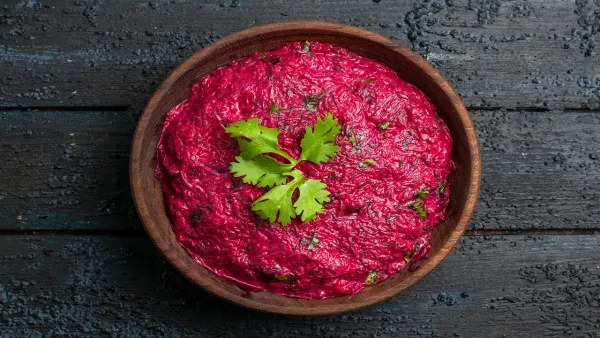
A lovely blend of tastes and textures, beetroot pachadi is a bright and savory South Indian dish that can be served at both celebratory gatherings and regular meals. In South Indian culinary terminology, pachadi refers to a particular kind of side dish that usually combines sour, spicy, and sweet flavors in harmony.

Earthy beetroot is the main ingredient in this recipe, adding its natural sweetness and eye-catching color. Blended with creamy yogurt, fragrant spices, and a tadka (tempering) of curry leaves and mustard seeds, the beetroot is cooked until it is soft and finely shredded. A favorite side dish for rice, roti, and other main courses, the resultant pachadi has a pleasing blend of flavors. Those who have the pleasure of tasting beetroot pachadi are enthralled with its visually attractive appearance and delicious taste profile.
Simple Recipe for Beetroot Pachadi
Ingredients needed to make beetroot kachadi or pachadi:
– One medium beetroot, grated and peeled
One cup of curd or plain yogurt
Add salt to taste.
Boiling water
One teaspoon of oil, ideally coconut oil
Half a teaspoon of mustard seeds
Add half a teaspoon of cumin seeds.
Two to three dry red chilies
A pinch of hing, or asafoetida
One curry leaf sprig
Two teaspoons of optionally grated coconut
One or two chopped green chiles (modify to taste)
– Garnish with coriander leaves
How to Prepare Beetroot Pachadi:
Bring the beetroot to a boil.
Pour enough water into a saucepan to cover the grated beets.
After adding a bit of salt, bring the grated beetroot to a boil until it softens. Usually, this takes five to seven minutes.
After the beets are cooked, remove the water and set them aside.
2. Get the yogurt mixture ready:
Whisk the yogurt in a mixing dish until it’s smooth.
Mix well after adding the cooked beets to the yogurt.
At this point, you may incorporate the shredded coconut into the yogurt mixture.
3. Get the seasoning ready:
In a small pan, heat the oil over medium heat.
Let the mustard seeds sputter after adding them.
Curry leaves, dried red chilies, and cumin seeds should be added. Sauté until aromatic, a few seconds.
Add chopped green chilies and a dash of asafoetida (hing). For a few more seconds, sauté.
4. Put Everything Together:
Mix well after adding the spice combination to the beetroot-yogurt mixture.
Adjust the seasoning if needed and add salt to taste.
5. Present and Garnish:
Add chopped coriander leaves to the Beetroot Pachadi as a garnish.
Serve the pachadi with any South Indian cuisine, such as steaming rice.
The Advantages of Beetroot Pachadi
Beetroot Pachadi’s primary component, beetroot, offers a variety of possible health advantages in addition to a taste explosion. The following are some advantages of consuming beetroot pachadi:
Beetroot is rich in vital elements, such as vitamins (including folate and vitamin C), minerals (such potassium and magnesium), and dietary fiber.
Beetroot’s abundance of antioxidants, especially betalains and anthocyanins, may help fight oxidative stress and lower the chance of developing chronic illnesses.
Heart Health: Beetroot’s nitrates have the potential to enhance blood flow, widen blood vessels, and reduce blood pressure, all of which may support heart health in general.
Digestive Health: Beetroot’s dietary fiber helps boost gut health by encouraging regular bowel motions and a healthy digestive system.
Anti-Inflammatory: The body may experience less inflammation if some beetroot chemicals, such as betalains, have anti-inflammatory qualities.
Possible Exercise Benefits: Studies have shown that the nitrates in beetroot improve endurance and oxygen usage during exercise.
Aids in Detoxification: Compounds in beetroot help the body’s natural detoxification systems, especially the liver.
Beetroot’s nitrates may increase blood flow to the brain, which might boost cognitive performance and lower the risk of cognitive decline.
Weight management: Beetroot’s high fiber content may help minimize overeating and increase feelings of fullness, both of which are advantageous for managing weight.
Skin Health: By encouraging the creation of collagen and guarding against oxidative damage, the antioxidants and nutrients in beetroot help support healthy skin.
Cancer Prevention: Although further study is required, several studies indicate that the phytonutrients in beetroot may have anti-cancer potential.
Blood Sugar Regulation: When included in a balanced diet, the fiber and minerals in beetroot may help maintain stable blood sugar levels.
In Malayalam and Other Areas, Beetroot Pachadi
A classic South Indian meal, beetroot pachadi, sometimes called beetroot kichadi, is well-liked across the country, especially in areas like Kerala, Tamil Nadu, and Andhra Pradesh. In these areas, it is often made and consumed in homes as well as during festivals, weddings, and other special events. The fundamental idea of mixing beets with yogurt and spices is the same, yet each state may have its own variants in terms of the spices used or the cooking technique.
In Kerala, the traditional Onam Sadhya, a sumptuous vegetarian meal offered during the Onam festival, often includes beetroot pachadi. It is frequently eaten as a side dish with regular meals.
“Beetroot thayir pachadi,” which emphasizes the use of yogurt in the meal, is another name for beetroot pachadi in Tamil Nadu. It is often served with other traditional Tamil meals and rice.
Given Andhra Pradesh’s reputation for fiery food, adding green chilies or red chili powder might give the pachadi a little more spiciness.
Although beetroot pachadi is most popular in these locations, its popularity has spread beyond them because of the ease with which recipes can be shared and the cultural influences. Because of this, beetroot pachadi may be found in various regions of India as well as among the Indian diaspora worldwide in different forms or variants.